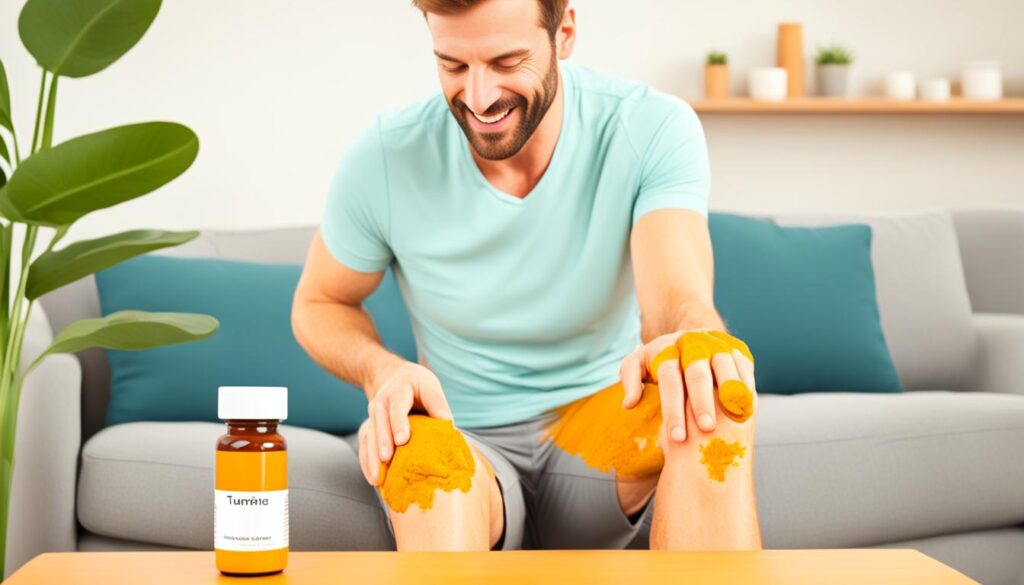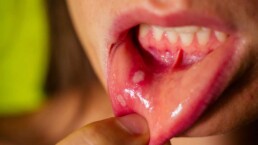If you’re facing knee pain often, don’t worry. Many people deal with knee issues. This can be due to overuse, injuries, arthritis, or being overweight. But, the good news is you can try lots of home remedies to help ease your knee pain without drugs. This guide will show you many safe and budget-friendly ways to make your knees feel better at home.
Table of Contents
ToggleYou can use common methods like the RICE (Rest, Ice, Compression, Elevation) technique. Or try different things like tai chi or natural ointments. This guide will give you plenty of easy ways to handle your knee pain well. You can figure out how to lessen swelling, move better, or just feel more comfortable.
Want to say goodbye to knee pain and be more active again? Keep reading to learn the best ways to treat knee pain at home. You can start your journey to getting rid of knee pain naturally.
Assess Your Knee Pain
Knee pain can be bothersome. It’s important to figure out why it’s happening. This helps know if you need a doctor or you can fix it at home.
Think about how bad the pain is, how long it lasts, and what it feels like. This info will help a lot.
When to Seek Medical Attention
Strong knee pain that lasts, or has other bad signs, needs a doctor. They will check you over and may do some tests. This is to find out what’s wrong.
Here are some clear signs you should see a doctor:
- Sudden, severe pain in the knee
- Swelling that doesn’t go away
- Instability or locking of the knee joint
- Difficulty bearing weight on the affected leg
- Limited range of motion or mobility
- Persistent pain that doesn’t improve with rest and home treatment
After seeing your doctor, you should know what to do next. They will tell you the best way to treat your knee.
Don’t wait too long to see a doctor if your knee feels off. Even if it’s just a little pain, caution is best. Fast treatment can stop the problem from getting worse.
The RICE Method for Strains and Sprains
Did you hurt your knee by falling or twisting it? You can use the RICE method at home to help. RICE stands for Rest, Ice, Compression, and Elevation. It’s a great way to lower swelling, ease pain, and get better from minor knee problems.
The RICE plan was made public by Dr. Gabe Mirkin in 1978. It’s been used a lot by sports coaches and players. The idea is to rest a lot at first with ice. But now, some doctors think rest and ice may not always be the best idea to get better quickly.
Now, some research says rest and using too much ice might slow down getting better. It might even cause more harm. Instead, they suggest a plan like PEACE or MEAT. This includes gentle movement and avoiding too much rest.
Still, the RICE method is good for many injuries like minor knee sprains. Use it for the first few days. But, if it doesn’t get better in a week, see a doctor just to be sure.
Remember, the RICE method can’t help with serious problems like breaks. They need to be checked by a doctor right away.
Also, taking certain pain medicines can help. These include ibuprofen or naproxen. But, always check with a doctor first. And don’t forget to wear the right shoes and look after your body. This can keep your knees healthy and avoid more injuries in the future.
Understanding and using the RICE method at home is good for many knee problems. It helps you get better without needing to see a doctor too much. And it helps you feel well again faster.
Tai Chi for Knee Pain Relief
Tai chi helps people with knee osteoarthritis to manage pain and move better. It’s a slow, calming exercise from China. This practice includes breathing deeply, meditation, and gentle movements. Studies show it can lower knee pain and make moving your knee easier.
Tai chi is perfect for knee pain because it’s easy on the joints. The soft movements help the knee’s muscles and make you more stable and flexible. It also makes you stand better. Doing tai chi also helps your brain and body work together. This can lessen long-term pain and stress, making knee problems better.
If your knees hurt, try adding tai chi exercises for knee pain to your day. Find classes or videos made for tai chi for knee osteoarthritis. Start with the simple moves. Then, do more as you get better.
Including Mind-body exercises for knee pain like tai chi with other care can help a lot. This could include therapy, keeping a healthy weight, and medicine. Tai chi mixes body movements with a calm mind. This can really ease your knee pain and make life better.
Exercise for Knee Pain Management
Doing the right exercises can really help with knee pain. It’s best to stay away from high-impact sports. Instead, focus on activities that are gentle on the knees. These can make the muscles around your knees stronger, giving you relief.
Low-Impact Exercise Options
Here are some easy, knee-friendly exercises to try:
- Cycling – Riding a bike, either outside or on a stationary one, is great for building knee muscle. It doesn’t stress the knee joint too much.
- Swimming – If you love the water, swimming is perfect. It’s easy on the knees since it’s a zero-impact sport.
- Walking – Just walking is a great choice. It makes your knees more flexible and strengthens the muscles around them.
- Tai Chi – Tai Chi is a slow, balanced practice. It can make your knees stronger and more flexible.
It’s also good to do exercises that make your leg muscles, especially the quads, stronger. Choose from leg raises, step-ups, and squats. They help protect your knees.

Take exercise slowly and pay attention to how your body feels. Always check with a doctor before starting any workout plan. They can help you pick what’s best for you.
Weight Management for Knee Pain
If you’re having knee pain, your weight might be the reason. Too much weight makes your knee joints work harder and hurt more. The Arthritis Foundation says, 10 extra pounds can mean 15 to 50 pounds extra on your joints. By losing weight with healthy eating and moving more, you can ease the pain in your knees. This helps with knee osteoarthritis and other knee issues too.
A study in the Indian Journal of Community Medicine shows that half of Indians over 50 have knee pain. Being overweight makes it worse, like with obesity and knee osteoarthritis. But losing weight can really help.
Dropping pounds can really change how your knees feel. In a study, people who lost about 2 pounds a month saw less swelling over time. Getting to a healthy BMI, 18.5–25, by losing 10 percent of your weight can cut down knee pain. It also helps keep your joints from getting worse.
Doctors can help you make a plan to lose weight in a healthy way. The NHLBI says to eat well and move more to lose about 10 percent of your weight in six months. This can protect your knees from pain and lower the chances of osteoarthritis.
Losing weight for knee pain isn’t just about making your joints work less. It also makes you healthier with lower blood pressure, better cholesterol, and balanced blood sugar. Managing your weight means getting a handle on your knee health and your overall health too.
Heat and Cold Therapy for Knee Pain
If your knee hurts, using heat and cold therapy might help. Heat makes your muscles relax. It also makes your joints work better by making them smoother.
Cold therapy decreases the redness and puffiness in your knee. By switching between cold and warm, your pain might get better.
Tips for Applying Heat and Cold
If you want heat and cold therapy to work well, remember these tips:
- Use heat for no more than 20 minutes each time. A warm towel, heating pad, or bath can do the trick. It’s great for long-term pain like with arthritis. It can make moving easier.
- Put cold packs on your knee for the first 2 days after getting hurt. It cuts down on swelling and soreness. This is really helpful for new injuries, like twists.
- Change from heat to cold, then back again. Take a little break between to help your knee. This way works great for long-lasting knee pain.
- Make sure your heat and cold stuff isn’t too extreme. Don’t put them straight on your skin. You might get burned or freeze your skin.
Heat and cold treatments are good for home, but still talk to a doctor if your knee keeps hurting. They can find the real issue and suggest what to do next.
Herbal Ointments for Knee Pain Relief
If you have knee pain that won’t go away, consider trying herbal ointments. Studies show that these natural remedies might work as well as store-bought creams. Ingredients like cinnamon, ginger, mastic, and sesame oil could ease knee pain. Many folks swear by using herbal creams for knee pain and topical pain relievers for knees.
The good thing about natural anti-inflammatory ointments is they’re gentle. They help lessen knee joint swelling and pain, making it easier to move. You could avoid prescription drugs by using these natural options.
Before you try any new remedy, talk to your doctor. Make sure using herbal creams for knee pain is safe for you. This is really important if you have health problems or take other medicines.
Deciding to use natural anti-inflammatory ointments is up to you. Remember, they might be less powerful than what your doctor could give. But with your doctor’s advice, you can pick what’s best for your knee pain. Choosing wisely will help you feel better and move easier.
Willow Bark for Potential Pain Relief
Willow bark is a natural helper for pain, like knee pain, for many years. It has salicin, similar to aspirin, that might fight inflammation. Some tests show it can lower knee pain, but more study is needed.
In the past, it was used in China and Europe for back pain, arthritis, and more. Willow bark’s salicin can be from 0.08% to 12.6%. More salicin (about 240 mg) can help more with pain.
Safety Considerations for Willow Bark
There are some things to watch out for with willow bark. Too much can upset your stomach or cause bleeding. Avoid it if you’re pregnant, breastfeeding, or take certain meds.
It’s not for everyone. People with asthma, diabetes, and some other health issues should pass. Kids under 18 shouldn’t have it.
Always talk to a doctor before trying willow bark or any supplement for knee pain.

Ginger Extract for Arthritis Pain
Ginger is great for easing knee pain from arthritis. It’s known for its anti-inflammatory powers. Many studies check out how ginger helps our joints.
Studies have found awesome stuff about ginger. For example, a 2000 study saw that ginger could work as well as ibuprofen. When used with echinacea, it lessened pain and swelling after knee surgery. Also, in 2001, researchers discovered that ginger helped a lot with knee pain from osteoarthritis.
There are different ways to take ginger, like in supplements, teas, or in foods. A study from 2015 found that using ginger with regular arthritis medicine could lower pain. Plus, ginger is a good source of antioxidants and fights inflammation, making it potentially helpful for knee osteoarthritis, joint pain, and relieving arthritis pain naturally.
But, not all studies agree on ginger’s knee pain benefits. While some are hopeful, some say it’s just okay. Always talk to your doctor before using ginger for your pain.
Therapies to Avoid for Knee Pain
Some home remedies might help with knee pain. But, some treatments are not a good idea. For example, don’t use glucosamine and chondroitin sulfate. Also, avoid hydroxychloroquine and transcutaneous electrical nerve stimulation (TENS). Studies show these don’t really work and might cause problems.
Talk to a doctor before trying any alternative therapies to avoid for knee pain. Some supplements for knee osteoarthritis could mix badly with your medicines. Working with your doctor is key. This way, you can find safe and good ways to help with your knee pain.
- Glucosamine supplements
- Chondroitin sulfate
- Hydroxychloroquine
- Transcutaneous electrical nerve stimulation (TENS)
Home remedies can be part of your plan. But, it’s very important to work with a doctor. With the best care, you can lessen your knee pain. This will make your life better.
Knee Pain Home Remedies
Having knee pain all the time is tough. But, there are many good home remedies to help you feel better. These ideas work whether your knee hurts from a fall, too much use, or arthritis.
The RICE method is easy and works well for knee pain. It means Rest, Ice, Compression, and Elevation. Resting and putting ice on your knee can make the swelling go down. Raising your leg also helps. Epsom salt baths are good too. They can make you feel better and calm inflammation.
Doing easy exercises helps a lot. Things like walking, swimming, or biking are great. They make the muscles around your knee strong. This helps your knee but doesn’t push it too hard. Being a healthy weight is another big part. It takes off the pressure from your knees.
Turmeric and willow bark can reduce knee pain because they fight swelling. But, check with your doctor first before trying new things. They can tell you if these are safe for you, especially if you’re already taking medicine.
Using different safe home remedies for knee pain can make a big difference. Natural treatments for knee pain and self-care for knee discomfort often work well without using medicine or seeing a doctor. But, always listen to your body. If your knee pain doesn’t get better or it gets worse, see a doctor. They can help you figure out the best plan for you.

Acupuncture for Knee Osteoarthritis
Looking for other ways to ease knee osteoarthritis? Maybe acupuncture is what you need. This practice from China uses thin needles in body spots. Many see less knee pain because of it.
A special review in 2022 checked many trials on acupuncture. They found it helps with pain and making the knees work better. This shows it could be a good choice for treatment.
In 2017, a study showed acupuncture might lower knee pain. Participants felt better after real acupuncture. It worked better than fake acupuncture or just learning about knee pain.
Acupuncture is not the only treatment for knee osteoarthritis. You can use it with other treatments. Before you try it, talk to your doctor. They can suggest the best plan for your knee pain.
Tai Chi for Knee Osteoarthritis
Tai chi is an ancient Chinese practice that is thousands of years old. It includes easy movements, deep breaths, and focus. These make it good for people looking to feel better from knee pain and discomfort due to knee osteoarthritis.
Benefits of Tai Chi for Knee Pain
Studies show that doing tai chi can help with knee pain from osteoarthritis. In a year-long study with 204 people, tai chi showed results similar to physical therapy or better. Those who did tai chi felt better, did more, and saw better quality of life.
Tai chi includes gentle exercises that can make leg muscles stronger. This helps the knee be more stable and feel less strained. Tai chi also helps the mind and body work together, which can make you more aware of how your body moves. This is really good for dealing with knee osteoarthritis.
Also, tai chi is good for lowering stress and helping you relax. This can make it easier to handle the emotional impact of knee pain. It can improve how you feel and your life quality overall.

Before you start tai chi, talk to your doctor, especially if you have other health problems or take medicine. An experienced teacher can show you the right way to practice. They will make sure it’s safe and good for you.
Medical Marijuana for Knee Pain Relief
Many people with knee pain are looking into medical cannabis for help. This includes a part called cannabidiol (CBD). Studies in animals say CBD might help with swelling and pain. But, we need more info on how well and safe it is for knees in people.
The cannabis plant has over 540 parts, including more than 100 cannabinoids. The main ones are tetrahydrocannabinol (THC) and CBD. THC makes you feel “high”, but CBD seems to help without that feeling.
A study in 2018 looked at over 1,400 people using CBD for health issues. Most used it for pain. In fact, over 700 used it for pain and almost 700 for arthritis. But, a study in 2021 found no big help from CBD for those with knee or hip arthritis compared to those who didn’t use it.
We still don’t know the right amount of cannabis to help with arthritis. Also, some CBD products might not be what they say they are. For example, in 2020, only about 31% of CBD items were labeled correctly.
The rules about using medical cannabis are different in each state. To find out what’s okay in your area, check the National Conference of State Legislatures website. And always talk to a doctor before you start using medical marijuana or CBD for your knee pain.
Conclusion
Knee pain can really slow you down. But, you have many ways to help at home. The RICE method, certain exercises, and some natural treatments can make a big difference. These steps are safe, don’t cost much, and are good for your joints.
With a mix of these steps, you can feel better and keep moving. This means you might not need big medical procedures. Always talk to your doctor, especially if the pain is bad or won’t go away. They can help you find the best plan.
Looking for simple ways to ease knee pain? This article’s tips are a great start. Learning about these methods can help a lot. It lets you take charge and feel better, improving how you live every day.
FAQ
What are some common causes of knee pain?
Knee pain can come from many things. This can be overuse, an injury, arthritis, or carrying too much weight.
When should I seek medical attention for knee pain?
If the pain is bad, lasts a long time, or comes with other bad signs, see a doctor. They can check what’s wrong.
How can the RICE method help alleviate knee pain?
The RICE method is Rest, Ice, Compression, Elevation. It helps with a hurt knee by reducing swelling and pain at home.
How can tai chi benefit people with knee osteoarthritis?
Doing tai chi can lessen pain and make moving your knee easier for people with knee osteoarthritis.
What types of exercises are recommended for managing knee pain?
Things like biking, swimming, walking, and tai chi are great. They make knee-supporting muscles strong and keep you moving.
How can weight loss help alleviate knee pain?
Being too heavy makes your knees work harder. Losing weight cuts this extra work. It helps with knee pain and arthritis.
How can heat and cold therapy be used to manage knee pain?
Warmth relaxes muscles and makes joints move better. Cold stops swelling. Using both can help your knee hurt less.
Are herbal ointments effective for knee pain relief?
Some research says that stuff like cinnamon, ginger, and sesame oil is good. They might work as well as drugstore ointments.
What are the potential benefits and risks of using willow bark for knee pain?
Willow bark acts like aspirin but may not help knee pain. Using it also has risks. Always talk to a doctor first.
How can ginger help alleviate knee pain, particularly for those with arthritis?
Ginger fights swelling and may cut knee pain, especially for arthritis patients. Use with your doctor’s advice.
What are some therapies that are not recommended for knee pain?
Doctors say no to some knee pain treatments. These include glucosamine, chondroitin, and TENS, as science doesn’t back them.
What other simple steps can I take to manage knee pain at home?
Stand and walk right, wear good shoes, take Epsom salt baths, and get massages. These can all help at home.
Can acupuncture help alleviate knee osteoarthritis pain?
Yes, studies say acupuncture can lower knee pain and make it easier to move for people with knee osteoarthritis.
How can tai chi specifically benefit those with knee osteoarthritis?
Tai chi seems to be as good as or better than physical therapy for knee osteoarthritis. It helps with pain and more.
What is the potential for CBD or medical marijuana to help with knee pain relief?
Some animal research shows CBD might help with knee pain. But more study is needed to know if it’s safe and good for people. Always ask a doctor first.
Source Links

This article is medically reviewed by Dr. Chandril Chugh, Board-Certified Neurologist, providing expert insights and reliable health information.
Dr. Chandril Chugh is a U.S.-trained neurologist with over a decade of experience. Known for his compassionate care, he specializes in treating neurological conditions such as migraines, epilepsy, and Parkinson’s disease. Dr. Chugh is highly regarded for his patient-centered approach and dedication to providing personalized care.








